An Improvement of Output Power in Doubly Salient Permanent Magnet Generator Using Pole Configuration Adjustment
Abstract
1. Introduction
2. Structural Topology and Key Design Parameters
3. Results and Discussion
3.1. Number of Stator and Rotor Poles Influences on the Generator Outputs
3.1.1. Magnetic Field Distribution Analysis
3.1.2. Phase PM Flux Linkage and EMF Analysis
3.1.3. Analysis of Cogging Torque and Electromagnetic Torque
3.2. Influences of Split Ratio on the Generator Outputs
3.2.1. Magnetic Field Distribution Analysis
3.2.2. Magnetic Flux Linkage and EMF Analysis
3.2.3. Analysis of Cogging Torque and Electromagnetic Torque
3.3. Influences of Stator Pole Arc on the Generator Outputs
3.3.1. Magnetic Field Distribution Analysis
3.3.2. Magnetic Flux Linkage and EMF Analysis
3.3.3. Analysis of Cogging Torque and Electromagnetic Torque
3.4. Analysis of Output Voltage and Output Power
4. Conclusions
Author Contributions
Funding
Conflicts of Interest
References
- Wang, Y.; Niu, S.; Fu, W. Electromagnetic performance analysis of novel flux-regulatable permanent magnet machines for wide constant-power speed range operation. Energies 2015, 8, 13971–13984. [Google Scholar] [CrossRef]
- Chau, K.-T.; Chan, C.; Liu, C. Overview of permanent-magnet brushless drives for electric and hybrid electric vehicles. IEEE Trans. Ind. Electron. 2008, 55, 2246–2257. [Google Scholar] [CrossRef]
- Cheng, M.; Hua, W.; Zhang, J.; Zhao, W. Overview of stator-permanent magnet brushless machines. IEEE Trans. Ind. Electron. 2011, 58, 5087–5101. [Google Scholar] [CrossRef]
- Li, H.; Chen, Z. Overview of different wind generator systems and their comparisons. IET Renew. Power Gener. 2008, 2, 123–138. [Google Scholar] [CrossRef]
- Zhang, Z.; Yan, Y.; Tao, Y. A new topology of low speed doubly salient brushless dc generator for wind power generation. IEEE Trans. Magn. 2012, 48, 1227–1233. [Google Scholar] [CrossRef]
- Shao, L.; Hua, W.; Dai, N.; Tong, M.; Cheng, M. Mathematical modeling of a 12-phase flux-switching permanent-magnet machine for wind power generation. IEEE Trans. Ind. Electron. 2015, 63, 504–516. [Google Scholar] [CrossRef]
- Gao, Y.; Qu, R.; Li, D.; Li, J.; Zhou, G. Consequent-pole flux-reversal permanent-magnet machine for electric vehicle propulsion. IEEE Trans. Appl. Supercond. 2016, 26, 1–5. [Google Scholar] [CrossRef]
- Zhao, J.; Yan, Y.; Li, B.; Liu, X.D.; Chen, Z. Influence of different rotor teeth shapes on the performance of flux switching permanent magnet machines used for electric vehicles. Energies 2014, 7, 8056–8075. [Google Scholar] [CrossRef]
- Hua, W.; Zhang, G.; Cheng, M. Investigation and design of a high-power flux-switching permanent magnet machine for hybrid electric vehicles. IEEE Trans. Magn. 2015, 51, 1–5. [Google Scholar] [CrossRef]
- Chen, H.; Aït-Ahmed, N.; Machmoum, M.; Zaim, M.E.-H. Modeling and vector control of marine current energy conversion system based on doubly salient permanent magnet generator. IEEE Trans. Sustain. Energy 2015, 7, 409–418. [Google Scholar] [CrossRef]
- Zhu, S.; Cheng, M.; Dong, J.; Du, J. Core loss analysis and calculation of stator permanent-magnet machine considering dc-biased magnetic induction. IEEE Trans. Ind. Electron. 2014, 61, 5203–5212. [Google Scholar] [CrossRef]
- Chau, K.-T.; Sun, Q.; Fan, Y.; Cheng, M. Torque ripple minimization of doubly salient permanent-magnet motors. IEEE Trans. Energy Convers. 2005, 20, 352–358. [Google Scholar] [CrossRef]
- Xu, W.; He, M. Novel 6/7 stator/rotor hybrid excitation doubly salient permanent magnet machine. IEEE Trans. Magn. 2016, 52, 1–5. [Google Scholar] [CrossRef]
- Yu, L.; Zhang, Z.; Chen, Z.; Yan, Y. Analysis and verification of the doubly salient brushless DC generator for automobile auxiliary power unit application. IEEE Trans. Ind. Electron. 2014, 61, 6655–6663. [Google Scholar] [CrossRef]
- Wang, Y.; Zhang, Z.; Yu, L. Investigation of a variable-speed operating doubly salient brushless generator for automobile on-board generation application. IEEE Trans. Magn. 2015, 51, 1–4. [Google Scholar] [CrossRef]
- Gong, Y.; Chau, K.-T.; Jiang, J.; Yu, C.; Li, W. Design of doubly salient permanent magnet motors with minimum torque ripple. IEEE Trans. Magn. 2009, 45, 4704–4707. [Google Scholar] [CrossRef]
- Wu, Z.; Zhu, Z.Q.; Shi, J.T. Novel doubly salient permanent magnet machines with partitioned stator and iron pieces rotor. IEEE Trans. Magn. 2015, 51, 1–12. [Google Scholar] [CrossRef]
- Cheng, M.; Chau, K.-T.; Chan, C. Characteristics of a new doubly salient permanent magnet motor. IEEE Trans. Energy Convers. 2001, 16, 20–25. [Google Scholar] [CrossRef]
- Sriwannarat, W.; Khunkitti, P.; Janon, A.; Siritaratiwat, A. An improvement of magnetic flux linkage in electrical generator using the novel permanent magnet arrangement. Acta Phys. Pol. A 2018, 133, 642–644. [Google Scholar] [CrossRef]
- Bottesi, O.; Alberti, L.; Gyselinck, J.J.C.; Gyselinck, J. Finite element small-signal simulation of electromagnetic devices considering eddy currents in the laminations. IEEE Trans. Magn. 2017, 53, 1–8. [Google Scholar] [CrossRef]
- Fasolo, A.; Alberti, L.; Bianchi, N. Performance comparison between switching-flux and IPM machines with rare-earth and ferrite PMs. IEEE Trans. Ind. Appl. 2014, 50, 3708–3716. [Google Scholar] [CrossRef]
- Kumar, P.; Bottesi, O.; Calligaro, S.; Alberti, L.; Petrella, R. Self-adaptive high-frequency injection based sensorless control for interior permanent magnet synchronous motor drives. Energies 2019, 12, 3645. [Google Scholar] [CrossRef]
- Buticchi, G.; Gerada, D.; Alberti, L.; Galea, M.; Wheeler, P.; Bozhko, S.; Peresada, S.; Zhang, H.; Zhang, C.; Gerada, C. Challenges of the optimization of a high-speed induction machine for naval applications. Energies 2019, 12, 2431. [Google Scholar] [CrossRef]
- Sriwannarat, W.; Siritaratiwat, A.; Khunkitti, P. Structural design of partitioned stator doubly salient permanent magnet generator for power output improvement. Adv. Mater. Sci. Eng. 2019, 2019, 2189761. [Google Scholar] [CrossRef]
- He, M.; Xu, W.; Ye, C. Novel single-phase doubly salient permanent magnet machine with asymmetric stator poles. IEEE Trans. Magn. 2017, 53, 1–5. [Google Scholar] [CrossRef]
- Lounthavong, V.; Sriwannarat, W.; Siritaratiwat, A.; Khunkitti, P. Optimal stator design of doubly salient permanent magnet generator for enhancing the electromagnetic performance. Energies 2019, 12, 3201. [Google Scholar] [CrossRef]
- Cheng, M.; Chau, K.-T.; Chan, C. Design and analysis of a new doubly salient permanent magnet motor. IEEE Trans. Magn. 2001, 37, 3012–3020. [Google Scholar] [CrossRef]
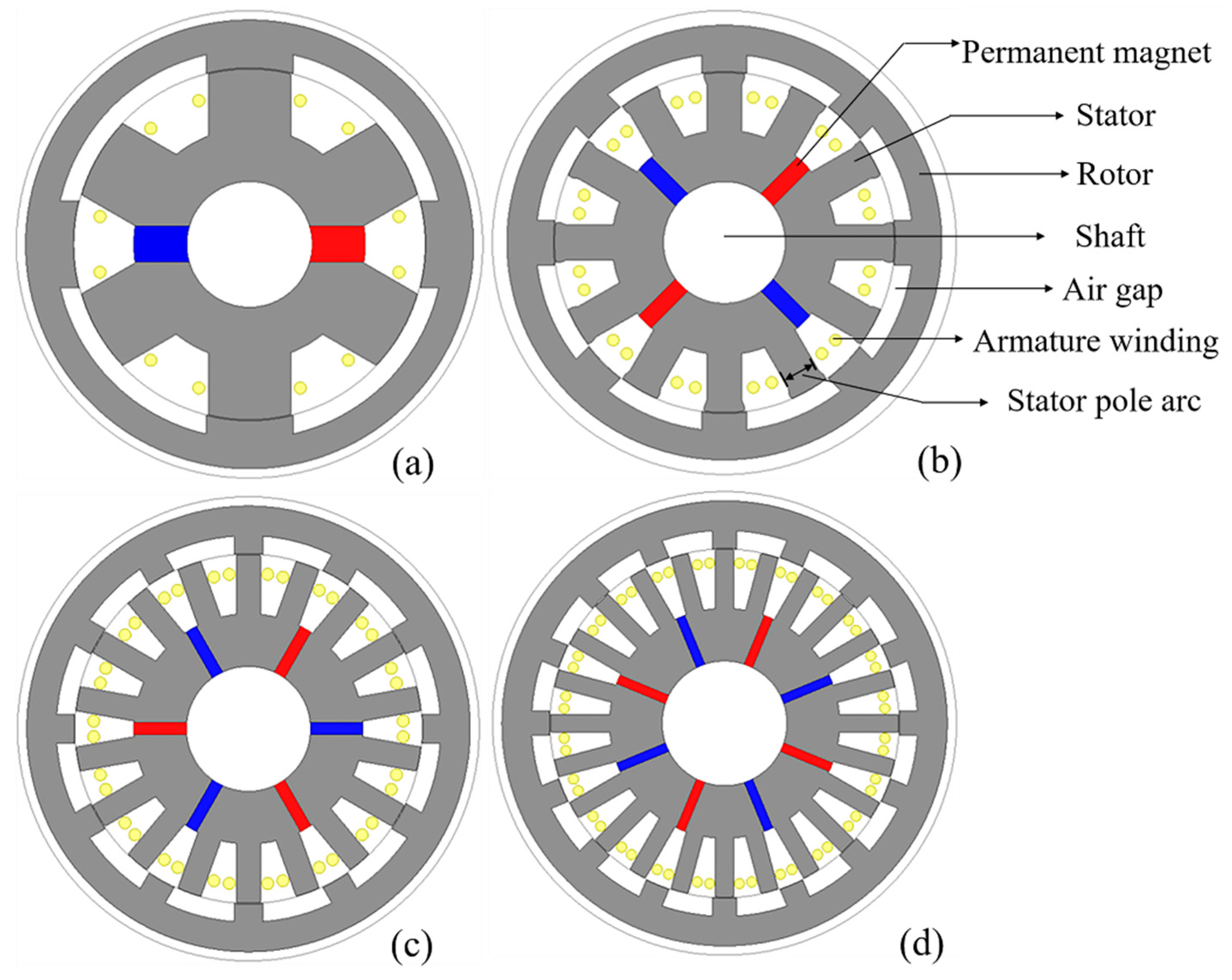

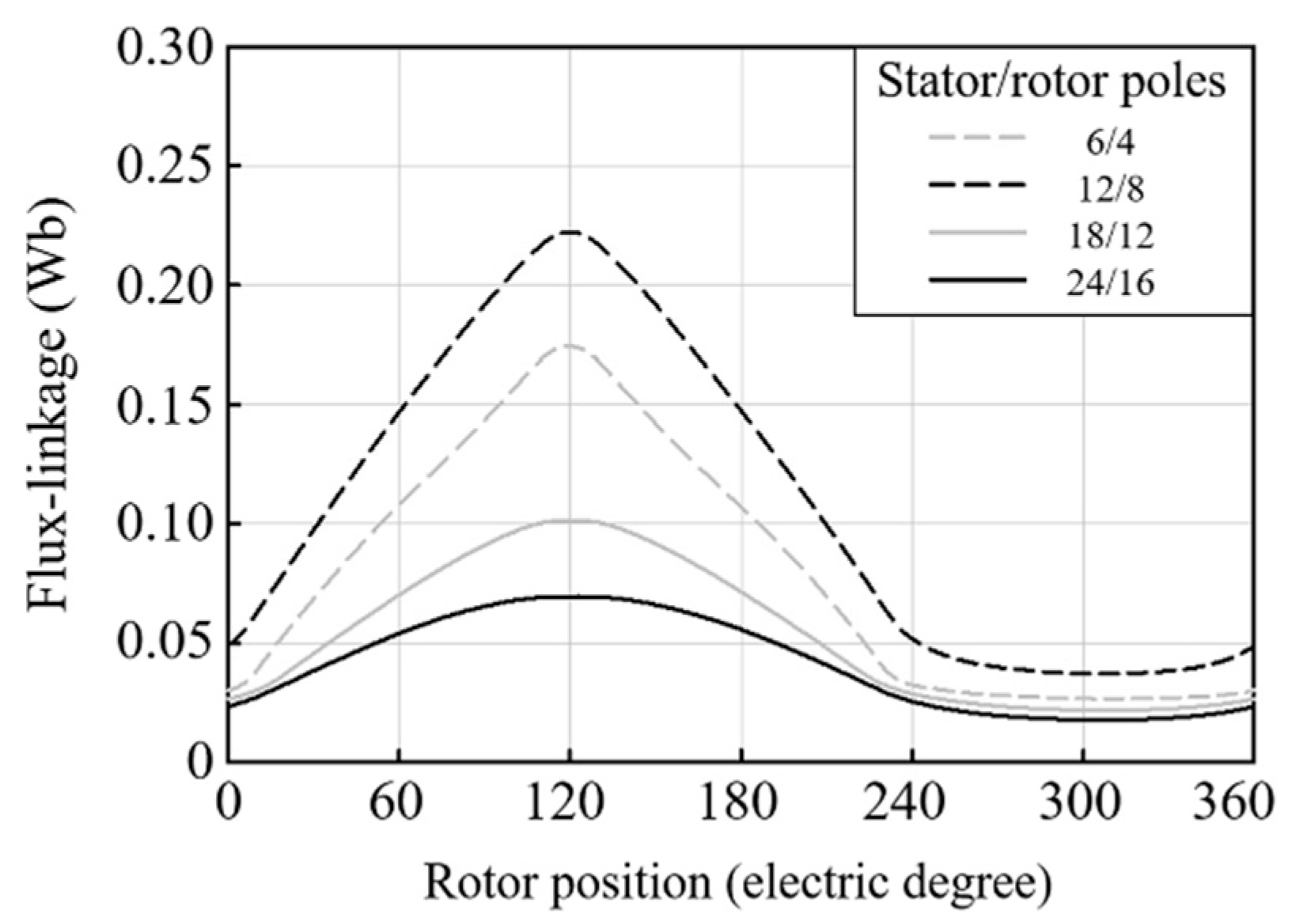

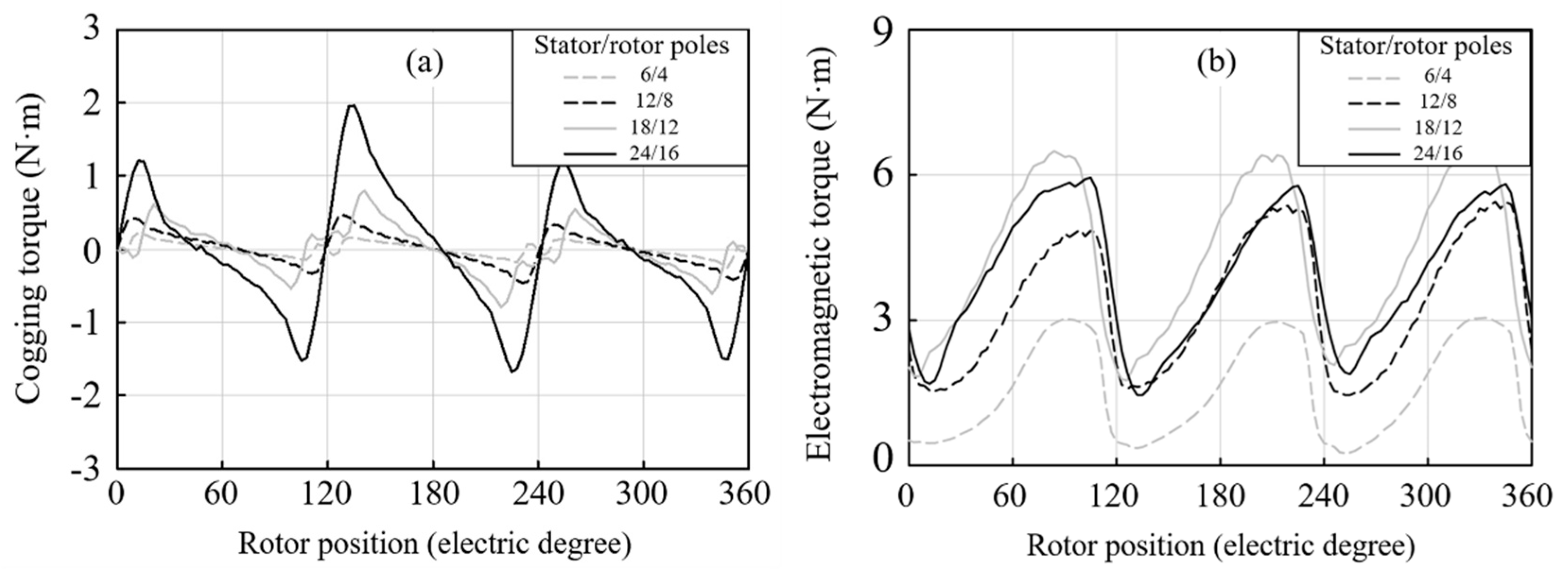
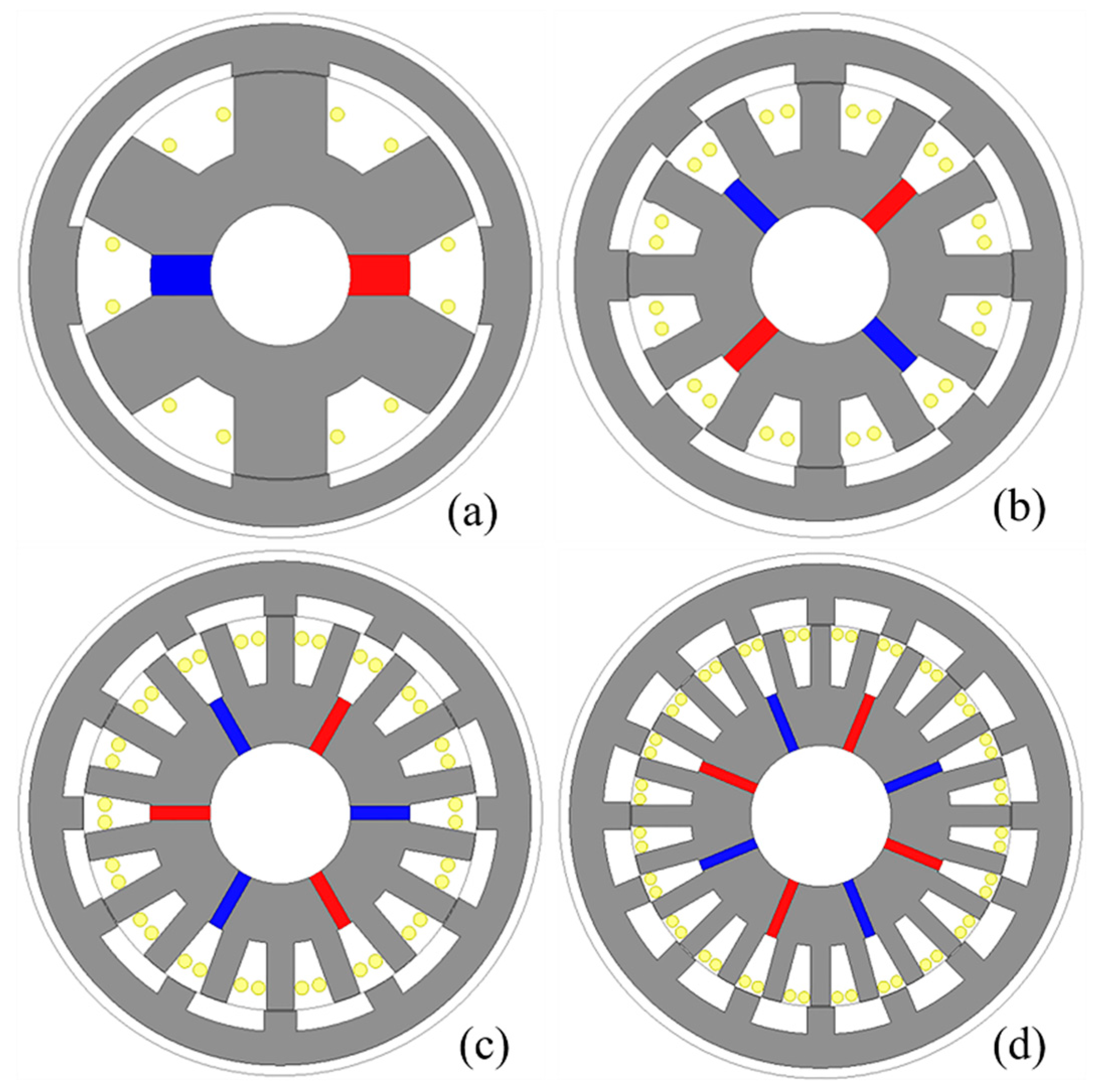
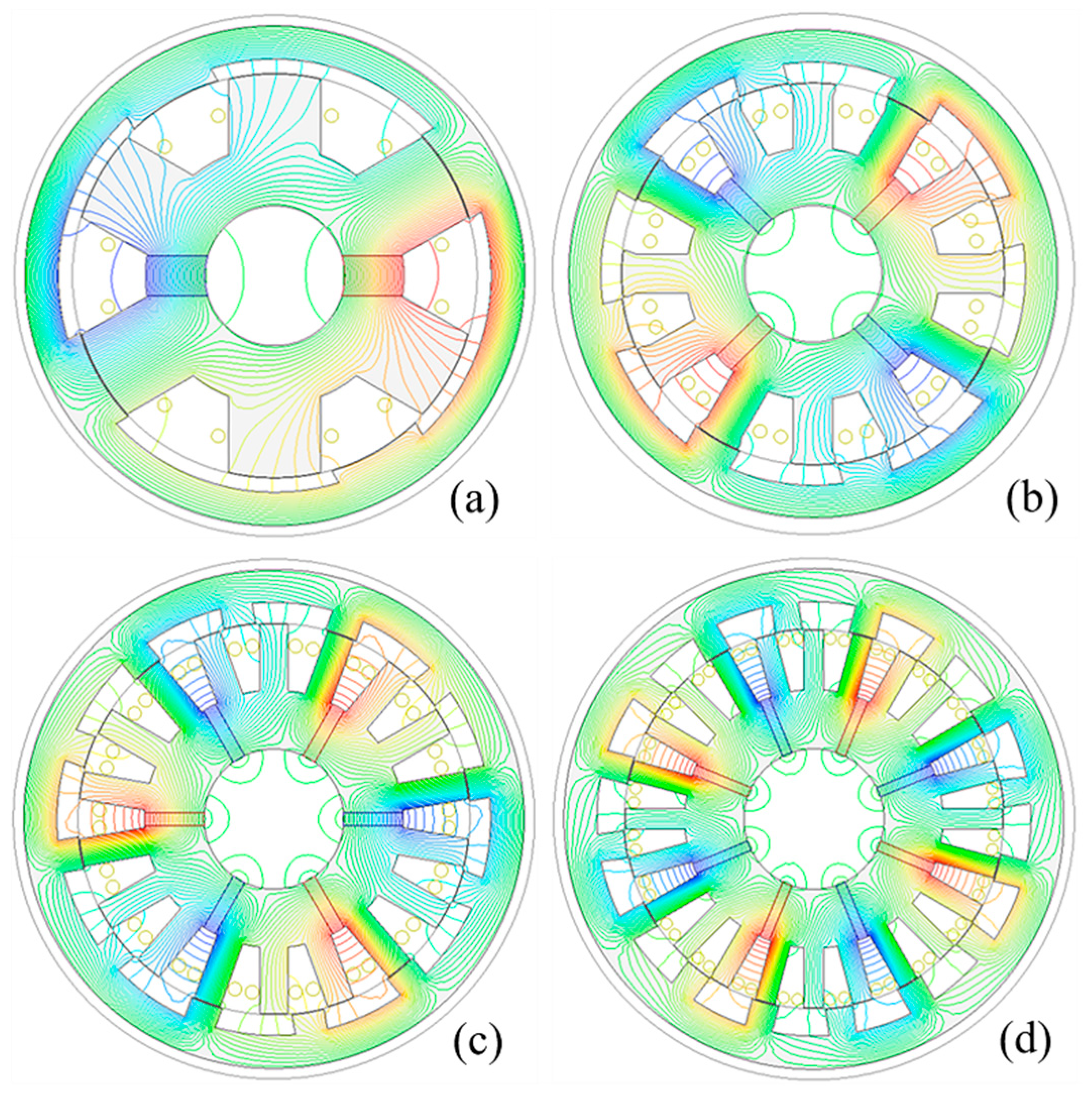
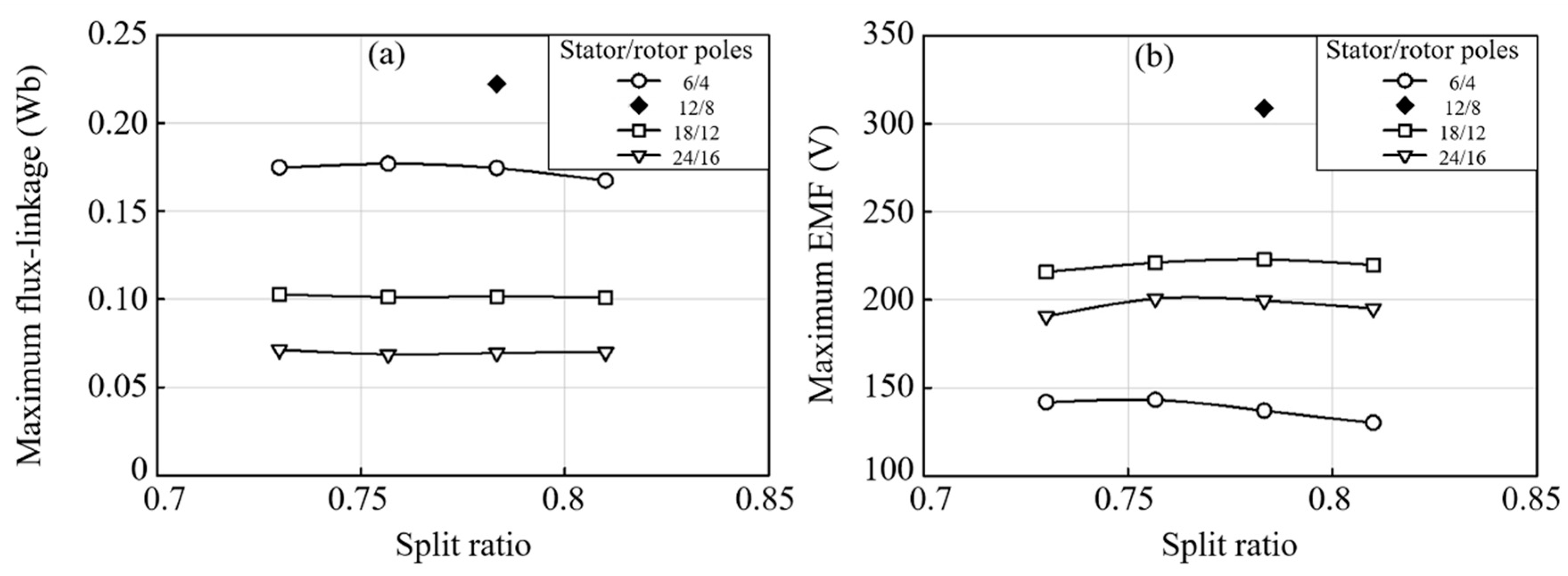
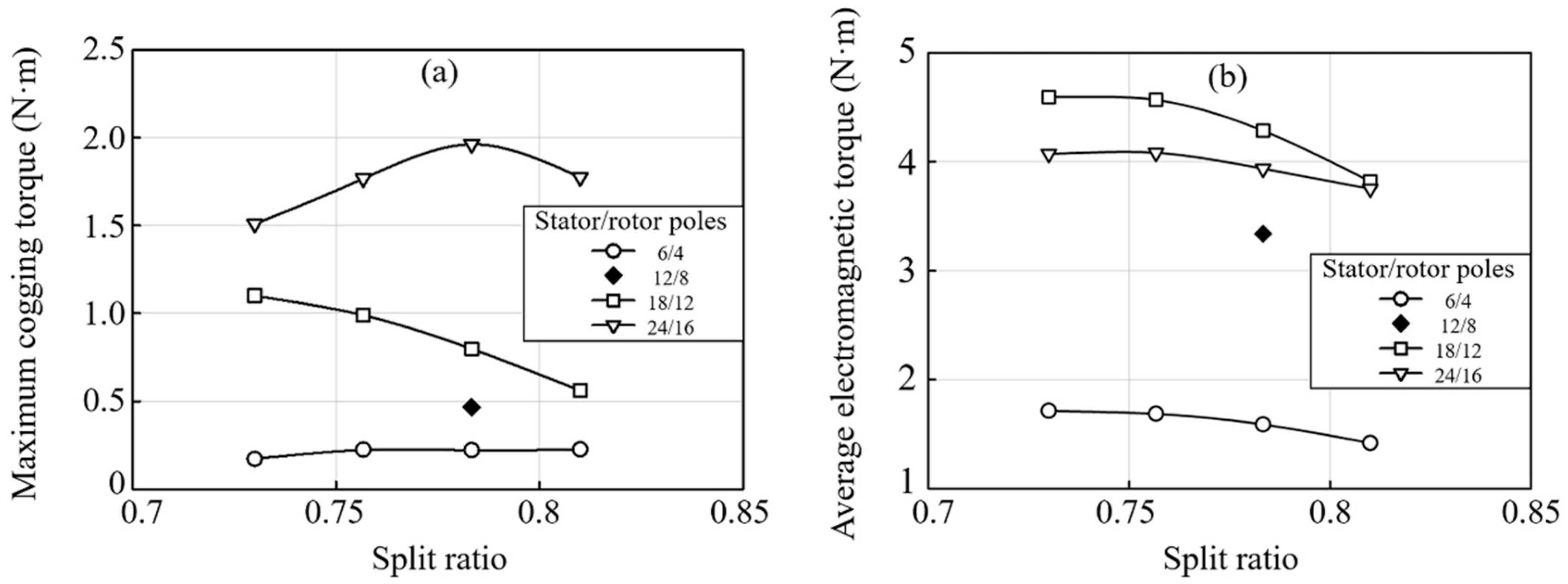
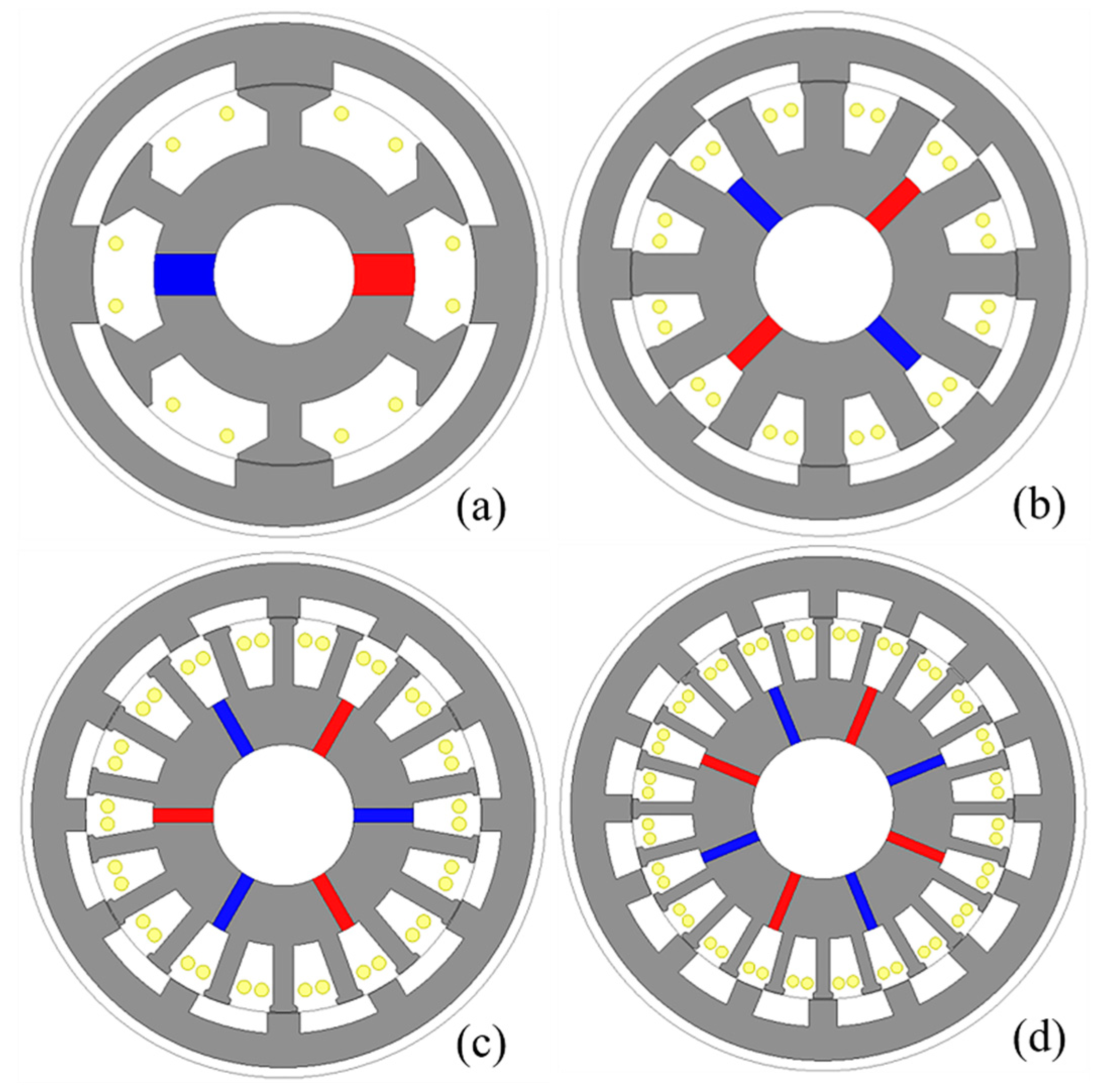



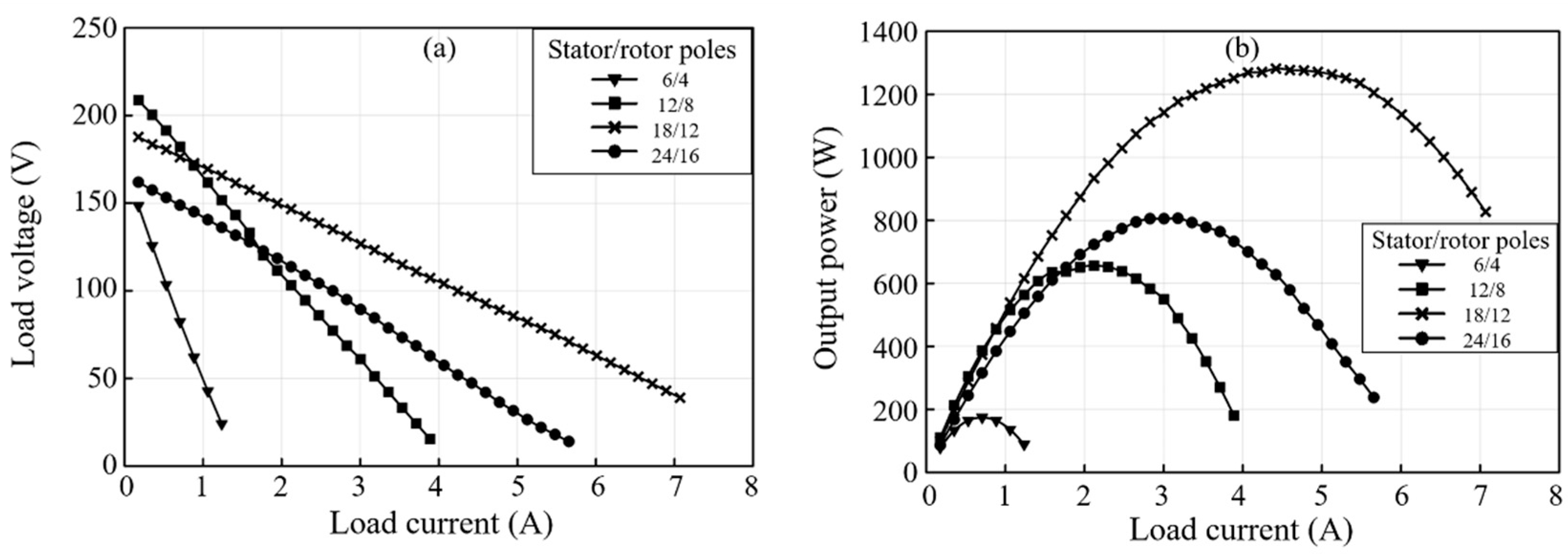
| Structural Parameters (Unit) | Value | |||
|---|---|---|---|---|
| The Proposed 6/4 Poles Structure | The 12/8 Poles Conventional Structure [26] | The Proposed 18/12 Poles Structure | The Proposed 24/16 Poles Structure | |
| Stator pole number | 6 | 12 | 18 | 24 |
| Rotor pole number | 4 | 8 | 12 | 16 |
| Outer diameter of rotor (mm) | 150 | |||
| Inner diameter of rotor (mm) | 118 | |||
| Air gap length (mm) | 0.45 | |||
| Outer diameter of stator (mm) | 117.5 | |||
| Inner diameter of stator (mm) | 42 | |||
| Stator pole depth (mm) | 19.8 | |||
| Rotor pole depth (mm) | 6 | |||
| Stator pole arc (°) | 27.22 | 12.72 | 8.08 | 5.88 |
| Rotor pole arc (°) | 32.18 | 15.04 | 9.53 | 6.93 |
| Number of permanent magnets | 2 | 4 | 6 | 8 |
| Permanent magnet thickness (mm) | 12 | 6 | 4 | 3 |
| Split ratio | 0.78 | |||
| Permanent magnet type | Nd–Fe–B | |||
| Radius of winding coil (mm) | 0.56 | |||
| Stator/Rotor Poles | Winding Turn (Turns) |
|---|---|
| 6/4 | 346 |
| 12/18 | 572 |
| 18/12 | 378 |
| 24/16 | 374 |
| Machine Structure | Machine Parameters | |||||
|---|---|---|---|---|---|---|
| The proposed 6/4 poles structure | Stator pole arc (degrees) | 27.21 | 24.11 | 20.10 | 15.76 | 11.21 |
| Winding turn per phase (turn) | 346 | 404 | 456 | 502 | 544 | |
| The 12/8 poles conventional structure | Stator pole arc (degrees) | 12.72 | ||||
| Winding turn per phase (turn) | 572 | |||||
| The proposed 18/12 poles structure | Stator pole arc (degrees) | 8.08 | 6.15 | 3.96 | ||
| Winding turn per phase (turn) | 378 | 464 | 545 | |||
| The proposed 24/16 poles structure | Stator pole arc (degrees) | 5.88 | 3.86 | 1.66 | ||
| Winding turn per phase (turn) | 374 | 490 | 598 | |||
© 2020 by the authors. Licensee MDPI, Basel, Switzerland. This article is an open access article distributed under the terms and conditions of the Creative Commons Attribution (CC BY) license (http://creativecommons.org/licenses/by/4.0/).
Share and Cite
Sriwannarat, W.; Seangwong, P.; Lounthavong, V.; Khunkitti, S.; Siritaratiwat, A.; Khunkitti, P. An Improvement of Output Power in Doubly Salient Permanent Magnet Generator Using Pole Configuration Adjustment. Energies 2020, 13, 4588. https://doi.org/10.3390/en13174588
Sriwannarat W, Seangwong P, Lounthavong V, Khunkitti S, Siritaratiwat A, Khunkitti P. An Improvement of Output Power in Doubly Salient Permanent Magnet Generator Using Pole Configuration Adjustment. Energies. 2020; 13(17):4588. https://doi.org/10.3390/en13174588
Chicago/Turabian StyleSriwannarat, Warat, Pattasad Seangwong, Vannakone Lounthavong, Sirote Khunkitti, Apirat Siritaratiwat, and Pirat Khunkitti. 2020. "An Improvement of Output Power in Doubly Salient Permanent Magnet Generator Using Pole Configuration Adjustment" Energies 13, no. 17: 4588. https://doi.org/10.3390/en13174588
APA StyleSriwannarat, W., Seangwong, P., Lounthavong, V., Khunkitti, S., Siritaratiwat, A., & Khunkitti, P. (2020). An Improvement of Output Power in Doubly Salient Permanent Magnet Generator Using Pole Configuration Adjustment. Energies, 13(17), 4588. https://doi.org/10.3390/en13174588







